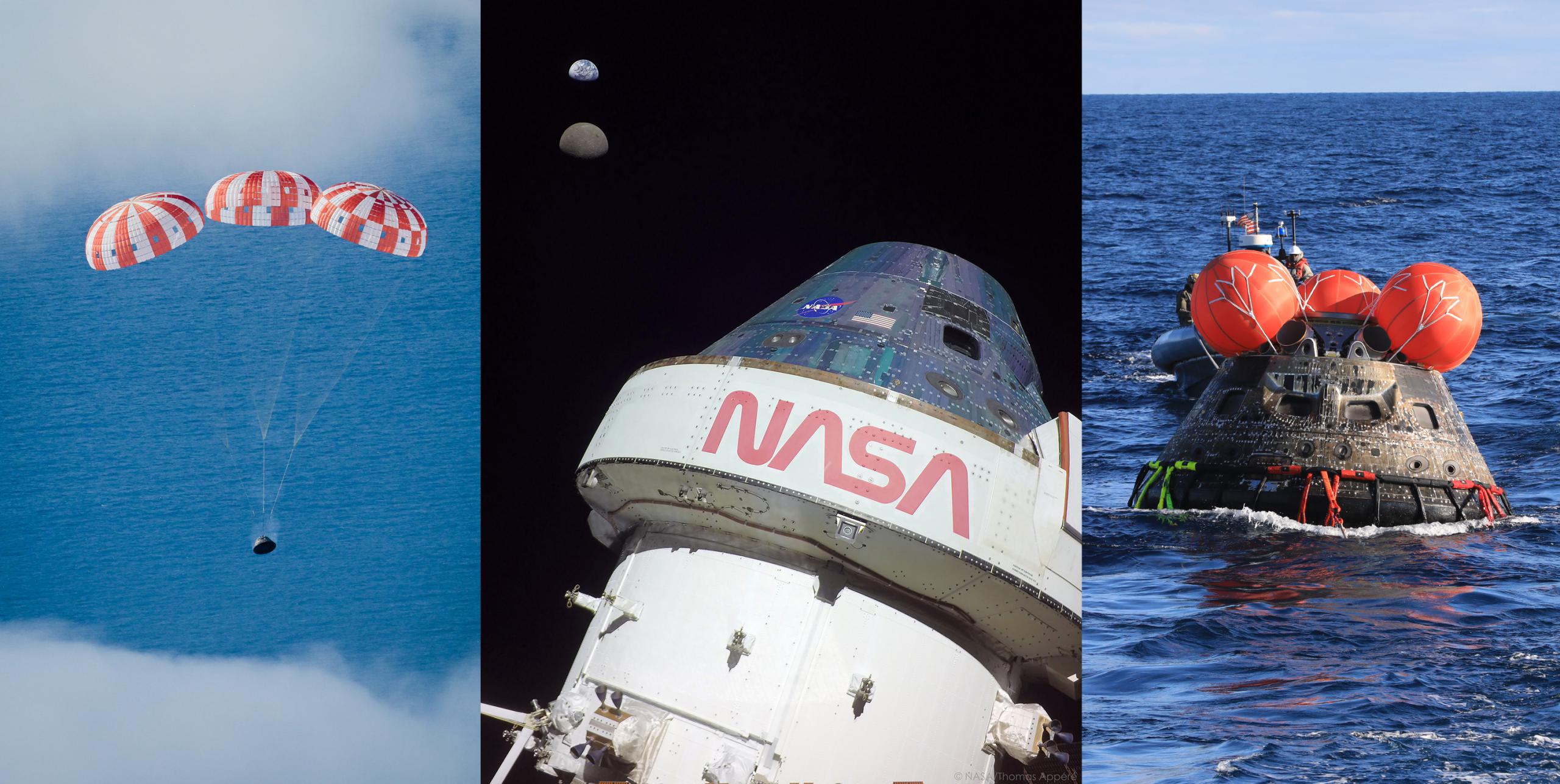

News
NASA’s first Artemis Moon mission a flawless success after Orion splashdown
NASA has successfully recovered an uncrewed version of its Orion crew capsule, marking the flawless completion of the spacecraft’s first Moon mission and the Space Launch System (SLS) rocket’s first launch.
Six years behind schedule, roughly $20 billion over budget, and costing taxpayers almost $50 billion through its first full flight test, anything less than near-perfection would have been a moderate scandal. But to the credit of NASA and its contractors, who have all worn excuses in the spirit of ‘perfection takes time’ threadbare, the international team behind Artemis I appears to have actually delivered on those implied promises. While some small bugs were unsurprisingly discovered over the 25-day mission, a collection of excellent post-launch NASASpaceflight.com interviews confirm that each major part of the SLS rocket performed about as flawlessly as their respective teams could have hoped for.
Originally intended to launch in late 2016, the first SLS rocket lifted off with the second space-bound Orion spacecraft on November 16th, 2022. Propelled by its European Service Module (ESM), Orion passed the Moon around November 21st. It then entered an unusual distant retrograde orbit (DRO) around the Moon on November 26th, reaching a record distance of 432,200 kilometers (268,563 mi) from Earth in the process. After less than a week in lunar orbit, Orion departed DRO on December 1st and began a long journey back to Earth.
The update that's rolling out to the fleet makes full use of the front and rear steering travel to minimize turning circle. In this case a reduction of 1.6 feet just over the air— Wes (@wmorrill3) April 16, 2024
On December 11th, about four weeks after liftoff, Orion separated from its disposable service module (~$400 million) and slammed into Earth’s atmosphere traveling around 11 kilometers per second (~25,000 mph). In another credit to NASA and capsule contractor Lockheed Martin, Orion’s reentry, descent, and splashdown all went perfectly. After its ablative heat shield did most of the work slowing it down, the spacecraft deployed parachutes and splashed down in the Pacific Ocean some 240 kilometers (~150 mi) off the coast of Mexico’s Baja Peninsula, southwest of California.
Taking full advantage of the fact that Orion and SLS are a government program and continuing in the footsteps of the Apollo Program, the US Navy was tasked with Orion spacecraft recovery. To that end, it deployed USS Portland – a 208-meter-long amphibious transport ship crewed by hundreds of sailors – to recover Artemis I’s Orion, which was completed without issue using the ship’s Navy helicopters, fast boats, and floodable well-deck.
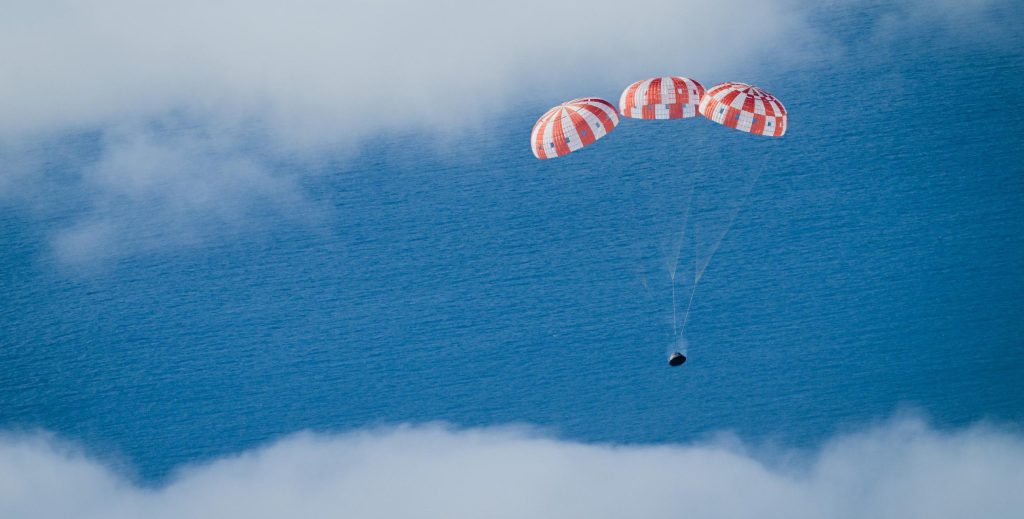
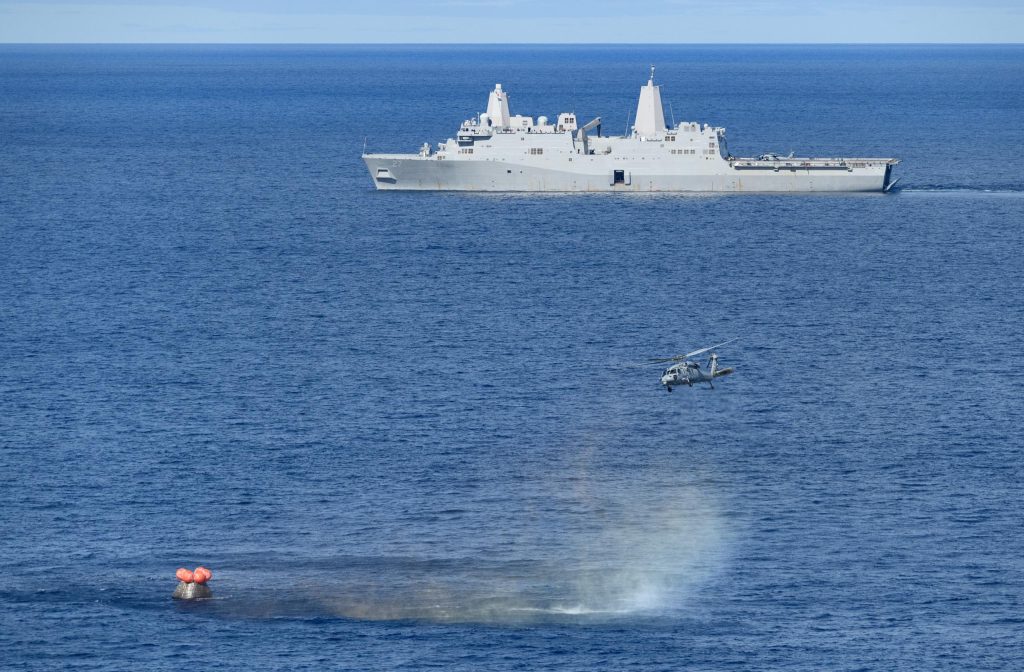
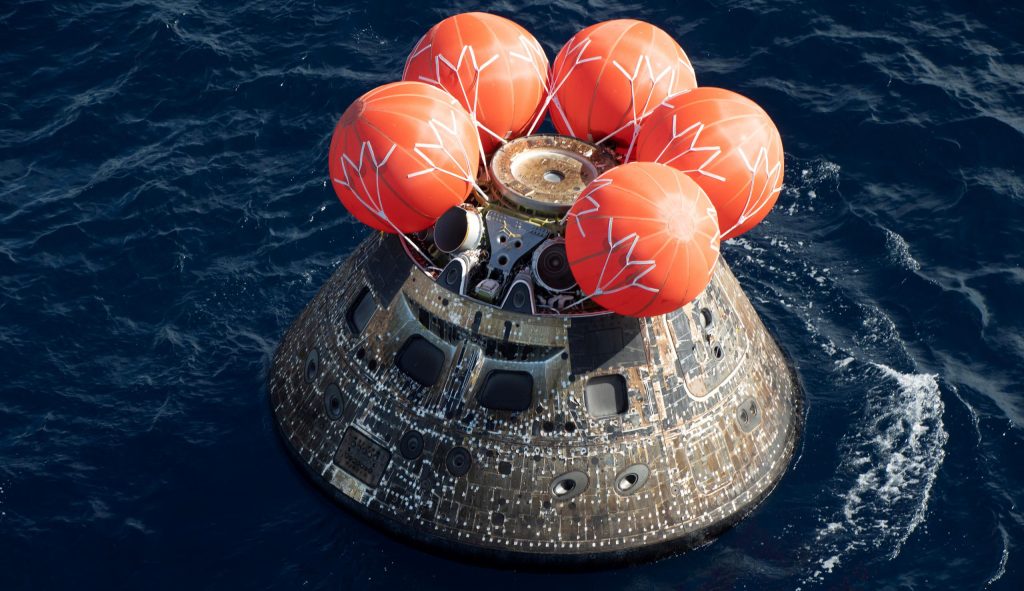
Following capsule recovery, which wrapped up almost seven hours after splashdown, it’s safe to say that NASA’s Artemis I mission was a spectacular, near-perfect success. Only a few aspects detract from the extraordinary performance of the spacecraft. Most significantly, despite being half a decade behind schedule and billions of dollars over budget, Artemis I’s Orion capsule and service module did not fly with or test a functioning docking port or Environmental Control and Life Support System (ECLSS). Those systems will not be tested in space until Artemis II, Orion’s first astronaut launch, inherently reducing the risk-reduction and predictive value of the flight test.
Additionally, Artemis I launched Orion to a distant retrograde lunar orbit. No future NASA missions are scheduled to use DRO. For the time being, Artemis II will be a free-return lunar flyby mission, meaning that Orion will never enter orbit around the Moon – the safest possible lunar trajectory for its crewed debut. For Artemis III and all future Orion missions, the spacecraft will enter a different near-rectilinear halo orbit (NRHO) around the Moon – similar to DRO in spirit but entirely different in practice. That again slightly reduces the value of Orion’s spectacular performance during Artemis I.
Waiting for Artemis II
Finally, due to a series of decisions and the shockingly slow expected performance NASA and its contractors, the next Orion and SLS launch is unlikely to occur before 2025. Recently discussed by the US Government Accountability Office (GAO) in a September 2022 report [PDF], the cause is strange. GAO says that “NASA estimates it will require ~27 months between Artemis I and Artemis II due to Orion integration activities and reuse of avionics from the Artemis I crew capsule on…Artemis II.” In other words, even though Artemis I was near-flawless, Artemis II will be delayed partly because of an attempt to reuse a tiny portion of its successfully recovered capsule.

Ars Technica’s Eric Berger recently provided another tidbit of painful context with the discovery that the decision to reuse the first deep space Orion’s avionics boxes was made eight years ago to close a “$100 million budget hole.” Inexplicably, NASA and Lockheed Martin believe it will take more than “two years to re-certify the flight hardware.” Berger explains that years ago, NASA only intended to launch SLS’s first Block 1 variant once, and expected that it would take at least three years to retrofit the rocket’s sole launch tower for the rocket’s Block 1B upgrade and second launch overall.
Years later, parochial pork-hungry members of Congress leaped on an opportunity to force NASA to build a second launch tower to help avoid that three-year gap between launches. Ironically, that second tower, ML-2, is now expected to cost anywhere from 2.5 to 4 times more than its original $383 million price tag and is years behind schedule. Meanwhile, SLS Block 1B is also years behind schedule, which led NASA to decide to launch SLS Block 1 three times instead of just once.
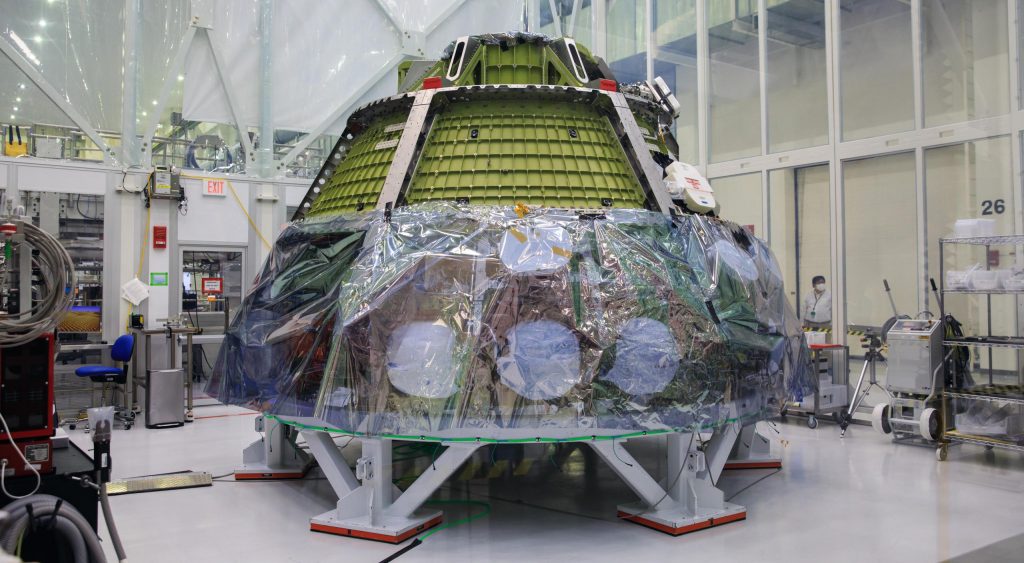

Ultimately, that means that the bizarrely slow recertification of eight Artemis I Orion avionics boxes – not the SLS rocket, ground systems, or any rework required after their launch debut – is now “the primary critical path for…Artemis II.” As a result, Berger estimates that delays caused by the decisions NASA made to save $100 million almost a decade ago will likely end up costing taxpayers $1 billion.
Artemis II is unlikely to launch less than 27 months after Artemis I, pegging the launch no earlier than February 2025. That gap of more than two years is just 20% shorter than the 33-month gap a NASA advisor once said could raise safety concerns because of the loss of experience that would result, which factored into the decision to build a second launch tower. Ultimately, NASA appears to have secured another very large chunk of time to ensure that Artemis II – like Artemis I – goes as perfectly as possible when the time finally comes.

News
Tesla (TSLA) receives “Buy” rating and $551 PT from Canaccord Genuity
He also maintained a “Buy” rating for TSLA stock over the company’s improving long-term outlook, which is driven by autonomy and robotics.

Canaccord Genuity analyst George Gianarikas raised his Tesla (NASDAQ:TSLA) price target from $482 to $551. He also maintained a “Buy” rating for TSLA stock over the company’s improving long-term outlook, which is driven by autonomy and robotics.
The analyst’s updated note
Gianarikas lowered his 4Q25 delivery estimates but pointed to several positive factors in the Tesla story. He noted that EV adoption in emerging markets is gaining pace, and progress in FSD and the Robotaxi rollout in 2026 represent major upside drivers. Further progress in the Optimus program next year could also add more momentum for the electric vehicle maker.
“Overall, yes, 4Q25 delivery expectations are being revised lower. However, the reset in the US EV market is laying the groundwork for a more durable and attractive long-term demand environment.
“At the same time, EV penetration in emerging markets is accelerating, reinforcing Tesla’s potential multi‑year growth runway beyond the US. Global progress in FSD and the anticipated rollout of a larger robotaxi fleet in 2026 are increasingly important components of the Tesla equity story and could provide sentiment tailwinds,” the analyst wrote.
Tesla’s busy 2026
The upcoming year would be a busy one for Tesla, considering the company’s plans and targets. The autonomous two-seat Cybercab has been confirmed to start production sometime in Q2 2026, as per Elon Musk during the 2025 Annual Shareholder Meeting.
Apart from this, Tesla is also expected to unveil the next-generation Roadster on April 1, 2026. Tesla is also expected to start high-volume production of the Tesla Semi in Nevada next year.
Apart from vehicle launches, Tesla has expressed its intentions to significantly ramp the rollout of FSD to several regions worldwide, such as Europe. Plans are also underway to launch more Robotaxi networks in several more key areas across the United States.
News
Waymo sues Santa Monica over order to halt overnight charging sessions
In its complaint, Waymo argued that its self-driving cars’ operations do not constitute a public nuisance, and compliance with the city’s order would cause the company irreparable harm.

Waymo has filed a lawsuit against the City of Santa Monica in Los Angeles County Superior Court, seeking to block an order that requires the company to cease overnight charging at two facilities.
In its complaint, Waymo argued that its self-driving cars’ operations do not constitute a public nuisance, and compliance with the city’s order would cause the company irreparable harm.
Nuisance claims
As noted in a report from the Los Angeles Times, Waymo’s two charging sites at Euclid Street and Broadway have operated for about a year, supporting the company’s growing fleet with round-the-clock activity. Unfortunately, this has also resulted in residents in the area reportedly being unable to sleep due to incessant beeping from self-driving taxis that are moving in and out of the charging stations around the clock.
Frustrated residents have protested against the Waymos by blocking the vehicles’ paths, placing cones, and “stacking” cars to create backups. This has also resulted in multiple calls to the police.
Last month, the city issued an order to Waymo and its charging partner, Voltera, to cease overnight operations at the charging locations, stating that the self-driving vehicles’ activities at night were a public nuisance. A December 15 meeting yielded no agreement on mitigations like software rerouting. Waymo proposed changes, but the city reportedly insisted that nothing would satisfy the irate residents.
“We are disappointed that the City has chosen an adversarial path over a collaborative one. The City’s position has been to insist that no actions taken or proposed by Waymo would satisfy the complaining neighbors and therefore must be deemed insufficient,” a Waymo spokesperson stated.
Waymo pushes back
In its legal complaint, Waymo stated that its “activities at the Broadway Facilities do not constitute a public nuisance.” The company also noted that it “faces imminent and irreparable harm to its operations, employees, and customers” from the city’s order. The suit also stated that the city was fully aware that the Voltera charging sites would be operating around the clock to support Waymo’s self-driving taxis.
The company highlighted over one million trips in Santa Monica since launch, with more than 50,000 rides starting or ending there in November alone. Waymo also criticized the city for adopting a contentious strategy against businesses.
“The City of Santa Monica’s recent actions are inconsistent with its stated goal of attracting investment. At a time when the City faces a serious fiscal crisis, officials are choosing to obstruct properly permitted investment rather than fostering a ‘ready for business’ environment,” Waymo stated.
News
Tesla FSD v14.2.2 is getting rave reviews from drivers
So far, early testers have reported buttery-smooth drives with confident performance, even at night or on twisty roads.

Tesla Full Self-Driving (Supervised) v14.2.2 is receiving positive reviews from owners, with several drivers praising the build’s lack of hesitation during lane changes and its smoother decision-making, among others.
The update, which started rolling out on Monday, also adds features like dynamic arrival pin adjustment. So far, early testers have reported buttery-smooth drives with confident performance, even at night or on twisty roads.
Owners highlight major improvements
Longtime Tesla owner and FSD user @BLKMDL3 shared a detailed 10-hour impression of FSD v14.2.2, noting that the system exhibited “zero lane change hesitation” and “extremely refined” lane choices. He praised Mad Max mode’s performance, stellar parking in locations including ticket dispensers, and impressive canyon runs even in dark conditions.
Fellow FSD user Dan Burkland reported an hour of FSD v14.2.2’s nighttime driving with “zero hesitations” and “buttery smooth” confidence reminiscent of Robotaxi rides in areas such as Austin, Texas. Veteran FSD user Whole Mars Catalog also demonstrated voice navigation via Grok, while Tesla owner Devin Olsen completed a nearly two-hour drive with FSD v14.2.2 in heavy traffic and rain with strong performance.
Closer to unsupervised
FSD has been receiving rave reviews, even from Tesla’s competitors. Xpeng CEO He Xiaopeng, for one, offered fresh praise for FSD v14.2 after visiting Silicon Valley. Following extended test drives of Tesla vehicles running the latest FSD software, He stated that the system has made major strides, reinforcing his view that Tesla’s approach to autonomy is indeed the proper path towards autonomy.
According to He, Tesla’s FSD has evolved from a smooth Level 2 advanced driver assistance system into what he described as a “near-Level 4” experience in terms of capabilities. While acknowledging that areas of improvement are still present, the Xpeng CEO stated that FSD’s current iteration significantly surpasses last year’s capabilities. He also reiterated his belief that Tesla’s strategy of using the same autonomous software and hardware architecture across private vehicles and robotaxis is the right long-term approach, as it would allow users to bypass intermediate autonomy stages and move closer to Level 4 functionality.








